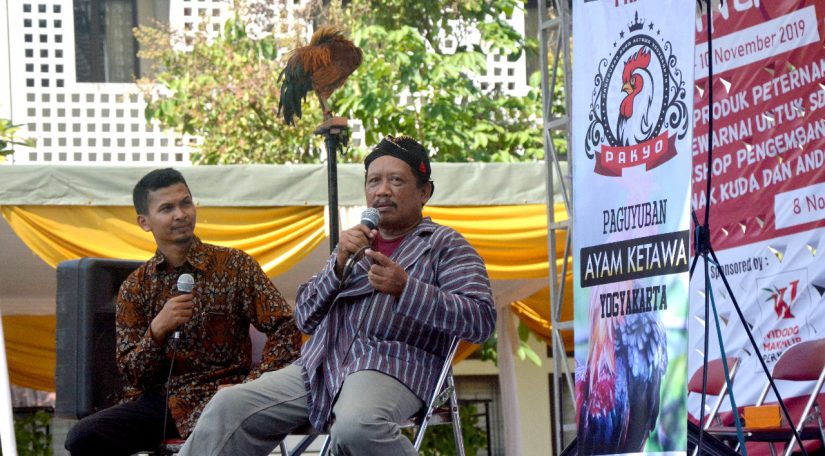
Preservation of ayam ketawa (laughing chicken) as a native germplasm of Indonesia is still carried out by hobbyist, the role of competent institutions in genetics and livestock breeding is still minimal.
Dean of the Faculty of Animal Science (FAS) UGM, Prof. Dr. Ir. Ali Agus, DAA, DEA, IPU, ASEAN. Eng, at the Gathering of Ayam Ketawa Hobbyist, Saturday (9/11) at the Gebyar Lustrum X, FAS UGM expressed readiness to be involved in the preservation and development of this original Sulawesi germplasm. It is because FAS UGM has a mandate to conduct research and development of livestock through conservation of native Indonesian germplasm so as not to become extinct or claimed by other parties.
One of the ways, Ali Agus revealed, was to partner with a practitioner or hobbyist of laughing chicken. “So on this 50th anniversary, we took the Association of Yogyakarta Ayam Ketawa Hobbyist (PAKYO) and the Preservation Association of Indonesian Laughter Chickens (P3AKSI) in Central Java to hold a meet-up event as well as a ayam ketawa show. Next year, we will have a bigger event, in the form of a contest,” he said.
According to Ali Agus, FAS UGM has the experts on poultry breeding that can help the direction of breeding and selection carried out by laughter chicken breeders so that universities with hobbies become one like two sides of a coin. For this reason, research in the field of genetics must still be carried out, including the characteristics and genetic characteristics of laughter. “So that hobbyists are not just fans, they are scientifically directed breeders. The association of laughter chicken hobbyists automatically becomes the association of laughter chicken breeders as native Indonesian chickens, “he said.
Galuh Adi Insani, S.Pt, M.Sc, lecturer and researcher from the Laboratory of Genetics and Animal Breeding of the FAS UGM revealed that they have started assisting ayam ketawa breeders in the PAKYO and the All-Indonesian Ayam Ketawa (P3AKSI) Laboratory of Central Java. “The original name of the laughing chicken is chicken gaga. At present, we only display about 20 chickens from the PAKYO members’ collection. We have received proposals to hold monthly contest training on campus, and to hold an annual contest as the culmination of a series of contests held by Pakyo and P3AKSI. We welcome the proposal and we will plan it together,” he explained at the event which was attended by 30 hobbyists of laughing chicken who were members of PAKYO, P3AKSI, fans of Solo and Central Java laughing chickens.
Galuh explained, as a chicken that enjoyed its voice, at present there is no scientific standard to assess the sound of chicken laughter. Although there are already sound standards according to fans, he stated that it needs scientific research. “The sound of laughter chickens is recorded digitally and then analyzed with the help of sound spectrum charts. The character of the rooster crowing in the form of sound volume, color, tempo, and duration will be known in measurable terms,” he explained.
The study of the laughter chicken sound spectrum, he explained, also helped to further objectify the judging of the laughter contest. He was referring to information from hobbyists that so far he still had to present a laughing chicken judge from South Sulawesi to judge the national level contest. “We also ask PAKYO and P3AKSI so that FAS UGM researchers can learn the judging standard. “To form judges from campus and to be studied scientifically,” Galuh said.
Heru Susanto, Chairperson of PAKYO, expressed his gratitude for being noticed by the FAS UGM and hopes that further cooperation can be even tighter in the form of mentoring and facilitation of activities such as joint exercises and contests. “We are also ready to help if there will be scientific research on this laughing chicken,” he said.
According to him, laughing chicken is the pet chicken of the Bugis kings, most are found in Sidrap, South Sulawesi, which then spread throughout the archipelago. In Solok, West Sumatra also found a type of laughing chicken, named after the Kokok Balenggek.
He explained, laughing chicken was so developed, so the crowing sound was getting better and better. “In the past, laughter only sounded gretek or disco, it was very fast tempo. Now dangdut rhythms appear slower and slowest. There is also a duration chicken, which can reach up to 1-2 minutes in length, usually used for male broodstock,” he explained.
Bambang Arif, chairman of the Central Java P3AKSI explained, the sound of a chicken is like a turtledove. The better the sound the day because of the selection by farmers. “But also don’t like the history of kneeling. In the past our good kneels were taken to Thailand and selected. Returning to Indonesia again is Bangkok’s kneeling which is far better than our kneeling. Don’t let there be a laughing chicken in Bangkok,” he revealed.(Nadia)
